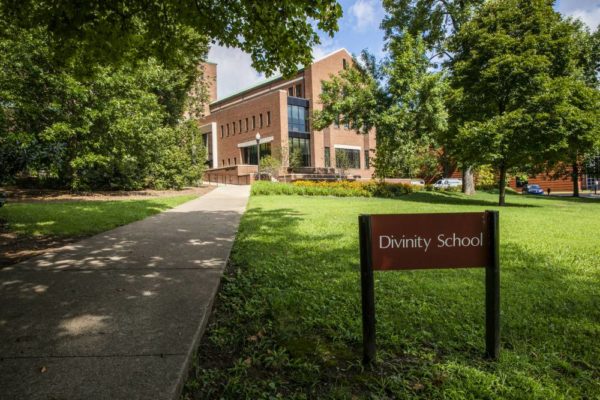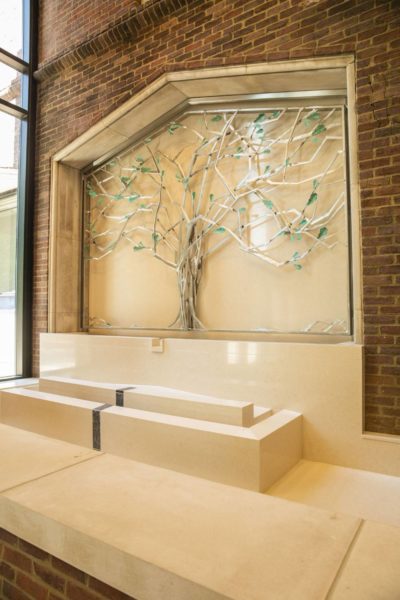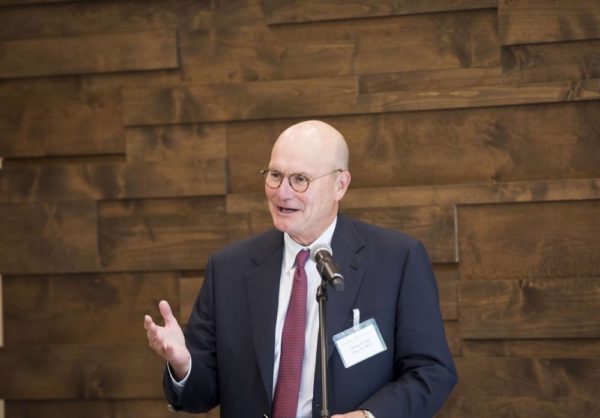
Faculty, staff, students and friends gathered at the Vanderbilt Divinity School to witness the dedication and ribbon cutting for the school’s much anticipated new expansion.
The $11.5 million three-year renovation project includes a 13,641-square-foot addition that is fully accessible and awash with natural light. The three-story addition has five new classrooms with smart technology, expanded and updated conference rooms, renovated office space, a new multi-faith chapel and a terrace for quiet reflection. Making use of repurposed materials and other environmental features, it is projected to achieve LEED silver certification.

The E. Rhodes and Leona B. Carpenter Foundation helped launch the renovation with a $2.8 million gift. The new addition will be known as the E. Rhodes and Leona B. Carpenter Foundation Wing. The foundation’s previous support of the Divinity School includes creating scholarships, endowing faculty chairs and the establishment of the Carpenter Program in Religion, Gender and Sexuality.
The new spaces were designed by Gilbert, McLaughlin, Casella Architects, and Orion Building Corporation served as construction manager.
“For decades the Vanderbilt Divinity School has exemplified our university’s mission of service while shaping ministry and bringing about social justice,” said Interim Chancellor and Provost Susan R. Wente. “In these new inviting and welcoming spaces people will be able to engage in civil dialogue and discourse and learn how to become more engaged citizens. I can think of nothing more important that we need to be doing together.”
“This is our gift to the world – a physical space that reflects a sacred mission … a place to make good the talents that we’ve been given by the Holy.”
–Dean Emilie Townes
This is the first renovation of the Divinity School since 1960, and in recent years it became clear the building no longer met the university’s standards for teaching or its goals for inclusivity and collaboration.

“This began in October 2013, my first year as dean, and I did not see myself as a builder,” said Dean Emilie M. Townes, the E. Rhodes and Leona B. Carpenter Professor of Womanist Ethics and Society, as she addressed those gathered in the new multi-purpose worship space. “But then I watched students interact in our classrooms, and the faculty struggle to teach in our classrooms and I thought, ‘We’ve got to do something.’ This is our gift to the nation and the world — a physical space that reflects a sacred mission. This space makes people better than who they are, and provides a place to make good the talents that we’ve been given by the Holy.”
One of the most significant changes to the facility is the creation of an accessible and distinguishable main entrance and lobby fronting 21st Avenue. This ingress facilitates the school’s mission to serve as a welcoming gathering place for the community, regardless of faith or creed.
The focal point upon entering is a commissioned tree sculpture and water wall, symbolizing growth and universal connection. Framed by an existing masonry arch, the tree is composed of stainless steel, with its leaves crafted of copper salvaged from one of the former side entrances.

“Water and wood are powerful symbols of cleansing and rebirth in sacred architecture, so we wanted to incorporate those into the design,” said Kent McLaughlin of Gilbert, McLaughlin, Casella Architects. “We really wanted that to be the first thing people experienced: the sculptural tree with the sound of water running through its branches and its leaves, and the roots extending down into the pool.”
A blue granite pathway leads visitors from the water feature across the lobby, into the new worship space, and ultimately out to the garden. The path is intersected by 12 black granite tiles engraved with words that exemplify the Divinity School’s vision for its students and guests, such as “peace,” “joy” and “wonder.”
The multi-faith worship space is the epicenter of the school, its chancel framed by a rustic wood-stacked wall, invoking warmth and a sense of nature. Tall colorful glass windows face southward offering views of the stained glass of Benton Chapel, reminding visitors of the school’s long-held tradition of ministry and social justice in the Nashville community.
Alumni may recall the tradition of graduating students taking photographs by a stone pediment engraved with the Latin term “schola prophetarum,” or “school of prophets.”
That architectural piece was salvaged and is prominently featured in the main stairwell of the building addition, along with a distinctive pendant light fixture also reclaimed from the prior space.

The design plan accommodated a cherished beech tree on the north side of the courtyard, which claims multiple outdoor nooks for quiet contemplation and solitary reflection. The exterior of the addition mimics the original structure with the inclusion of reclaimed limestone and handmade brick. Bruce R. Evans, chairman of the Vanderbilt University Board of Trust, recounted to the gathering his own experience as a Vanderbilt engineering student who often spent hours studying in the Divinity School’s quiet courtyard, recalling that the divinity students were always welcoming.
“The Divinity School is the spiritual center, the moral compass of the university, and the place where students can come to learn about ethical issues and the social justice issues of the day,” Evans said. “As a university we’re enriched by the presence of the Divinity School, and this renovation leaves our divinity school better positioned to fulfill its role within the university.”
The renovation is part of a 10-year plan to provide accessible spaces, innovative classrooms and welcoming spaces for dialogue, scholarship and reflection.
When the Vanderbilt Divinity School first opened its doors in 1875, it was named Vanderbilt University’s Biblical Department.










